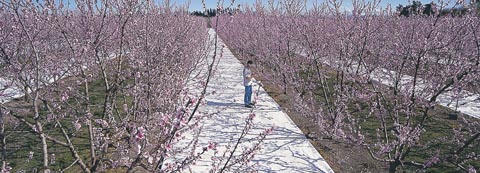
Washington State University scientists observed earlier harvests and larger fruit in a Rainier sweet cherry trial using white reflective material made by an Australian company. The research compared white and silver reflective material.
Photo courtesy of Extenday
Advanced maturity, increased fruit size, reduced number of pickings, and high yields were the second-year results of Washington State University research studying reflective material in sweet cherries.
During the first year assessing reflective material placed under cherries in 2004, scientists didn’t see improvement in fruit set, although weather during fruit set was perfect, reported WSU’s horticulturist Dr. Matthew Whiting.
But in 2005, Whiting observed significant differences between three types of reflective material placed in a fifth-leaf Rainier block planted in the Yakima Valley on Mazzard rootstock.
The types of reflective material-silver mylar and two types of white-were positioned in the orchard in late March at full bloom and left in place until July. The white Extenday and Daybright are both reflective products patented and developed by New Zealand researcher Jonathan Toye. Daybright is 10 percent less reflective than Extenday and allows for greater soil warmth.
The white materials were ten feet wide, whereas the silver material was five feet wide. Whiting noted that the different widths used were a drawback to the study.
High tonnage was picked from all three treatments, ranging from 9.5 to 10.6 tons per acre. Harvest dates in the Extenday and Daybright blocks were six to seven days earlier than the silver treatment. He added that fruit in the Extenday and Daybright treatments ripened earlier and picking was complete after the first three picks, reducing the number of picks from five to three.
Whiting found no difference in soluble solids or fruit firmness between the treatments. But a noticeable difference in fruit size was observed, with gains nearly 2.5 times in the white treatments compared to the silver treatment. He also noticed an increase in trunk diameter in the Extenday and Daybright treatments.
“We gained about a half-row size with Extenday and Daybright and had more 9-row fruit with those two treatments,” he said. “I suspect that we do have a positive effect on fruit set, but we don’t have empirical data to support that. But I do believe there is a slight positive effect in fruit set with Extenday, and we had significant increases in fruit size.”
“Because the results were so overwhelming, I’m interested to see if the one-year data is repeatable,” he said.

Leave A Comment